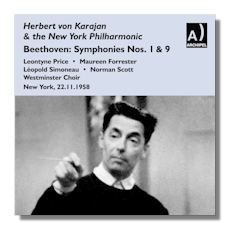
The Internet's Premier Classical Music Source
Related Links
- Beethoven Reviews
- Latest Reviews
- More Reviews
-
By Composer
-
Collections
DVD & Blu-ray
Books
Concert Reviews
Articles/Interviews
Software
Audio
Search Amazon
Recommended Links
Site News
 CD Review
CD Review
Ludwig van Beethoven

Karajan in New York
- Symphony #1
- Symphony #5 *
- Symphony #9 **
** Leontyne Price, soprano
** Maureen Forrester, contralto
** Léopold Simoneau, tenor
** Norman Scott, bass
** Westminster Choir
New York Philharmonic Orchestra/Herbert von Karajan
* Vienna Philharmonic Orchestra/Herbert von Karajan
Archipel ARPCD0556 2CDs
I am not sure if – and how many times – these particular performances have been kicking around on CD, nor am I sure if they sound better or worse elsewhere. What I do know is that the recordings here document Herbert von Karajan in his only appearances with the New York Philharmonic, conducting the composer he was to become known for worldwide. Furthermore, the Salzburg Vienna Fifth receives what is being billed as a "first ever release". While I cannot swear by it, I am content to take Archipel at its word, and say only that it enhances the appeal of this issue by quite a bit.
In 1958, Karajan visited New York for a series of all-Beethoven concerts, and picked the first and final works of the master's symphonic canon. He had already recorded all nine symphonies for EMI with the Philharmonia Orchestra, and would do so again a staggering three more times. The present albums preserve Karajan in an excitable state, tempos are urgent, and more importantly, his signature sound is in place. It's impressive how Karajan imposes his will on the New Yorkers, and that even early in his career he was able to bring his vision out so clearly. Strings have a kind of polish and blend that Bernstein – who would have then been in his first season as sole director of the Philharmonic – probably would not have looked for or expected. These being live performances, balances also don't favor those aforementioned strings as they later would in Karajan's later studio performances. So the winds and brass are not only assertive, but audible. Say what you will about Karajan; while I have my own personal favorites as far as Beethoven recordings go, the man was a great conductor and that's apparent here. The recorded sound isn't great, but what you do hear is excellent.
I expected to enjoy the 9th Symphony most of all, and it does indeed come very close to the classic 1963 reading that remains a favorite for listeners the world over. While the recorded sound of that studio version runs circles around this one, there is an urgency and thrill in this live account that is well worth hearing. The great attention to detail and dynamics is just clear enough that on can understand why these concerts were so special. The vocal quartet is superb, and the choral singing is about as good as you can reasonably expect from the Westminster Choir. Most importantly, this 9th shows how much Karajan could bring to this score, one which he conducted throughout his life and to such acclaim.
Still, I said I expected to enjoy the 9th most of all. The 1st is a revelation, however, and will come as a surprise to those who see Karajan as a heavy-handed conductor. It's a scorcher of a performance, one that doesn't sound much like Karajan at all. Lean, with lots of forward motion, it also brings out all kinds of wonderful details, especially in the woodwinds. In the first movement, Karajan would later add a whole two minutes to his first (and very fine) stereo account; here, everything is as propulsive as one could ask. It's truly Karajan does New York, and I love it. After a lovingly shaped Andante which features some somewhat scrappy strings, the Menuetto is deftly and excitingly dispatched. Much less mechanically than the studio version, Karajan is able to generate genuine energy through flexibility of pulse and some really lovely phrasing. The finale seals the deal, a superlative romp to the finish line that is again more naturally flowing than the studio take. The New York Philharmonic sounds like it loved playing this, and it's something special.
The bonus 5th actually turns out to be one; the post-war Vienna Philharmonic was an unpredictable bunch, but Karajan literally whips them into shape. For a live account from 1948, it sounds pretty good, too. There are some rough and ready moments, to be sure, but the conductor's fiery and passionate rendition works surprisingly well with the less alluring ensemble qualities. The brass have a field day, ringing confidently in a way that Karajan would smother under mounds of strings. It's an exciting look at the work, and is so different than what we know of this artist that it stands as nothing less than an important historical document. Coupled with the lone memento of a unique musical partnership, this release demands your full attention.
Copyright © 2014, Brian Wigman





















